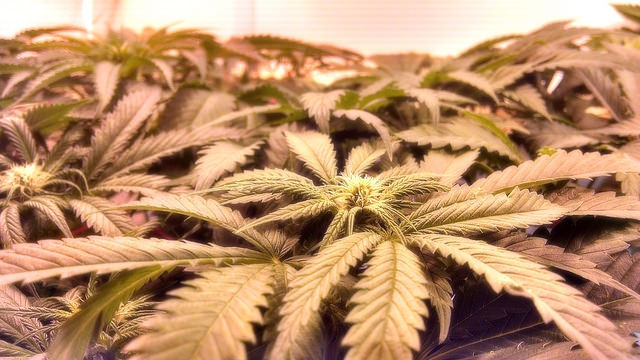
With local restrictions on marijuana easing across the U.S., power suppliers from California to Maine were expecting a little buzz of their own from newly legitimate pot farmers. After all, a 5,000-square-foot warehouse filled with hydroponic growing systems can draw five times the electricity of a typical industrial user.
But after an initial jolt in electricity use, when western states began legalizing marijuana cultivation and sales, demand has fallen off in some areas, according to utilities and analysts. That’s partly because the once-illicit business may no longer have to keep plants hidden from law enforcement and producers are upgrading to energy-efficient lights, pumps and cooling systems.
“You have to ask yourself: Why is weed grown indoors?” said Paul Patterson, a utility analyst at Glenrock Associates LLC in New York. “As it becomes legal, you’re going to see more go outside or in greenhouses.”
The sobering reality of pot power may prove a disappointment for American utilities hurt by stagnating electricity demand, with the rise of renewable energy like solar cells and more-efficient generators and appliances. Legalization of $3.5 billion U.S. cannabis market, where thousands of growers use energy 24 hours a day, was supposed to spark more consumption, even as it threatened to strain the nation’s aging transmission grid.
In the power industry, small demand increases can be significant. The U.S. Energy Department forecasts electricity consumption in the country will grow 1 percent a year or less through 2040.
When Colorado legalized marijuana, power use at the state’s biggest utility rose 1 percent to 2 percent, according to Xcel Energy Inc., a supplier in the state. Similar gains were reported in Washington and Oregon, where regulators were expecting the pot growers to consume enough power for a small city.
“We were thrilled to get that much load growth from one new industry,” said Mark Stutz, a spokesman for Xcel’s Public Service Co. of Colorado. “That just doesn’t happen to utilities.”
Evidence from neighboring states prompted California, which adopted its legalization laws in November, to host a workshop last month on how to handle the impending strain on the electric grid. Indoor cannabis growing accounted for about 3 percent of the state’s electricity consumption, or the equivalent of 1 million homes, according to a 2012 study cited by the California Public Utilities Commission.
Tacoma Growers
But some of the gains since legalization didn’t last.
In Tacoma, Washington, the municipal utility was preparing for a surge in consumption that proved much smaller than expected, said Chris Gleason, a spokeswoman for the city. At one growing facility, where demand was supposed to reach 12 megawatts, the operation is about half the size that was planned and using just 1.3 megawatts.
“Things like advanced LED lighting technology and smart growing methods have reduced the amount of electricity growers need,” Gleason said. “We didn’t have as many growers in our service area as we anticipated.”
Lighting Science Group Corp., a manufacturer based in West Warwick, Rhode Island, says one of its newest LED lights can increase a farm’s yield by 30 percent while reducing energy consumption by 45 percent compared with a conventional bulb.
Puget Sound Energy Inc., a power supplier based in Bellevue, Washington, helped supply more than 70 pot growers with LED lights and other upgrades that have saved more than 40 million kilowatt-hours over two years, said David Montgomery, the utility’s energy management consultant.
To be sure, legalized pot is still in its early phase. While 28 states have eased restrictions on the substance so far, not all allow recreational use that might lead to expanded production, and only some regions will have climates suitable for year-round outdoor cultivation.
Indoor growing operations in 2012 racked up at least $6 billion a year in energy costs, compared with $1 billion for pharmaceutical companies, according to research by Evan Mills, a senior scientist for California’s Lawrence Berkeley National Laboratory. Some larger facilities suck down as much as $1 million in power a month.
Moving Outdoors
While states like Colorado don’t yet allow marijuana to be grown outdoors, the rules are different in California, which is potentially the biggest market because it has the most people and the biggest economy. With plenty of agricultural land in the state, more farmers there may be induced to use greenhouses and the free power of the sun to expand production, rather than invest in more-expensive indoor systems.
And investors are watching. With legalization spreading across North America, Canada next week will launch the world’s first pot exchange traded fund, the Horizons Medical Marijuana Life Sciences ETF. And as new markets increase sales to $5.7 billion this year, U.S. investors have sought regulatory approval for a U.S. ETF, according to Bloomberg Intelligence.
Kristin Nevedal, project director at medical marijuana advocate Americans for Safe Access, predicts most of California’s weed farms will use natural light. At a workshop in San Francisco last month, she cited the example of a greenhouse with solar-powered fans that only circulate air to prevent overheating when the sun is out.
“Indoor came about because of prohibition,” said Adam Steinberg, a co-founder of Flow Kana, a San Francisco-based marijuana distributor. “Sun-grown cannabis in California has a real opportunity to buck the trend in energy consumption that other states have seen since legalization.”
Recommended for you
